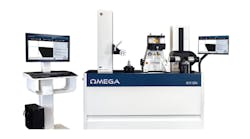Machined parts face various threats while in transit. A manufacturer’s packages can easily slide, shift, or fall while on the road, potentially damaging the components inside. Effective packing and shipping can help manufacturers prevent their parts from being damaged or destroyed while being transported. These are best practices to consider when shipping machined parts – and will help any manufacturer protect its products once they leave the shipping dock.
1. Use the right packaging material
Loose-fill packaging materials, like polystyrene packaging peanuts, may not properly secure a part and can generate static electricity if it shifts around. Bubble or shrink-wrap can keep a component in its packaging, preventing this from happening. Form-fitting cases or containers can provide similar protection.
Additionally, sizing boxes so that parts have little room to shift or slide while in transit can reduce the risk of damage. The right shape also will keep goods safe during shipping. Packing one box inside a larger one with additional packaging material around it also can provide extra protection.
Tightly packaging each part with enough material to secure it in its container will prevent any damage that can come from sliding or shifting during shipping.
2. Manage shipment weight
In general, boxes and packages that are too heavy are more likely to break in transit, and also will be more difficult to move. Finding ways to lighten individual shipments can reduce the risk of damage to the shipment.
Breaking particularly large shipments into multiple smaller packages can introduce new risks — smaller containers can be easier for carriers to lose. However, these items are easier to manage and less likely to break during handling.
Shipment weight also can guide packaging practices. Some shipped items may be heavy, no matter how they are organized or sent. A business should pay closer attention to these packages and ensure that they receive the material necessary to protect them while in transit. Heavier boxes may need more filler, proportionally, than smaller ones.
3. Use the right tape
Water-activated sealing tape, or gummed tape, can provide additional protection for heavy items. It can help prevent products from falling out of the bottom of a package in transit or while being handled.
Tape designed for packaging should always be used, even when shipping particularly light items. This will keep boxes sealed, preventing the product from falling out or being stolen. Tape that isn’t intended for packages may not be strong enough to keep containers closed during shipping — making it easier for parts to be damaged, lost or stolen before delivery.
Ultra-small and oddly shaped packages or part cases may need special tape or sealing. Some packaging specialists and carriers own machines that are built specifically to seal these small or irregular containers.
4. Communicate with carriers and clients
Communication is critical in shipping. Communicating shipping needs with carriers reduces the risk that shipped machined parts may be damaged during transit.
The right documentation ensures speedy delivery and that parts requiring special handling will receive the right care. Stickers or external markings – like a “fragile” or “open this side up” sticker – tell carriers that a package needs to be handled carefully or opened in a specific way.
Communicating with customers will ensure that shipped parts are properly handled, stored, and opened once delivered. If an item is particularly fragile and will buckle under weight, communication will ensure clients do not store other items on top of it.
5. Test the packaging
It can be hard to tell at a glance if a particular packaging strategy actually will protect parts during shipment. This is why practical knowledge about potential limitations is critical. Testing packaged items can tell manufacturers if the product is ready for transit.
Simply shaking light packages will demonstrate whether the shipped machined part will shift or move while in transit. Holding a box will show testers if packing tape has been properly applied and will provide some level of support to the shipped part.
More complex simulations, like a drop or impact test, will provide better information on how well a packaged part will survive shocks, falls, movement, and vibration.
Compliance with impact test standards like ISO 2244 and ASTM D880 will ensure a test follows established best practices and can effectively simulate transportation conditions.
Gathering data on the conditions that packages will be exposed to during shipment also may help a manufacturer conduct more effective tests. Tools like RFID tags and GPS trackers are assisting companies in tracking their goods during shipment.
Data from these sensors can show manufacturers what kind of speed and acceleration they should expect from a particular carrier’s drivers. Other tools, like smart accelerometers, can tell a manufacturer how much their shipped goods shift during in transit.
How to ship machined parts safely
It’s easy for a carrier to damage items when it ships machined parts. The correct packaging materials, shipment weight, tape and communication will help protect any shipped components.
Manufacturers also can test their packaging to ensure it will stand up to shipping conditions. Shake and drop tests make it easy to tell if a package is loose or will survive a fall. Businesses that do this can ensure their items reach customers in one piece and good condition.
Emily Newton is the Editor-in-Chief of Revolutionized, an online magazine exploring the latest industrial innovations.






